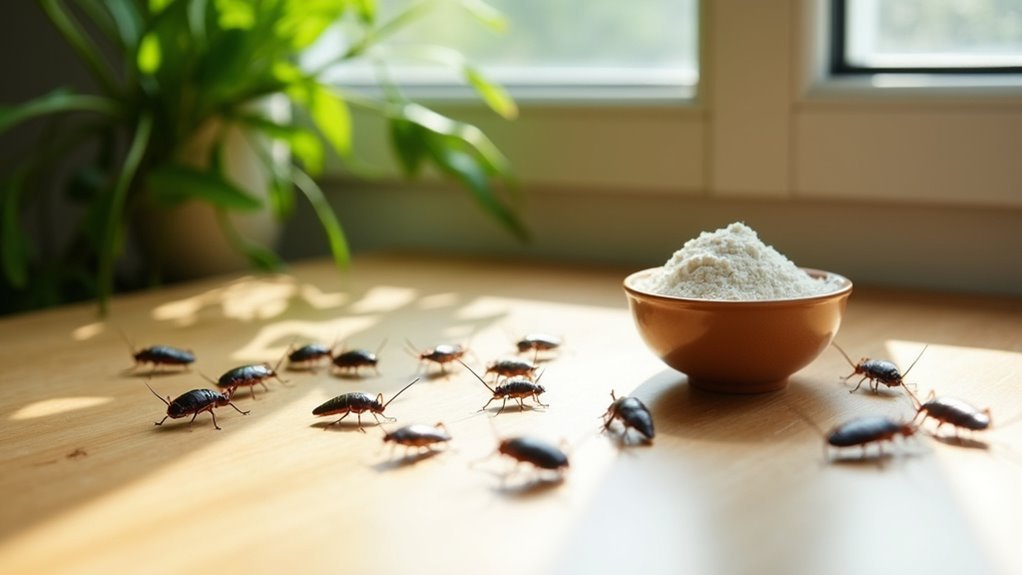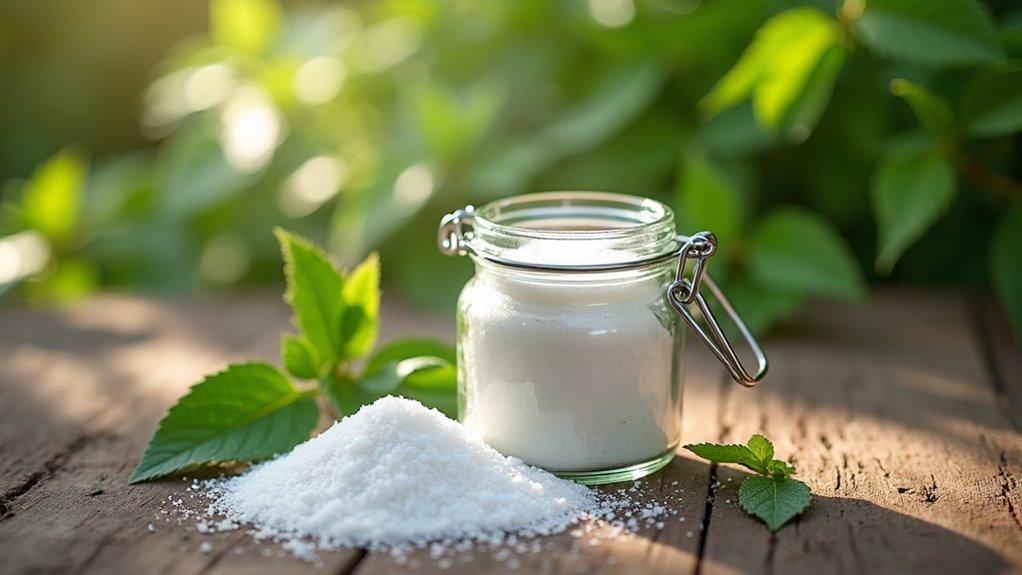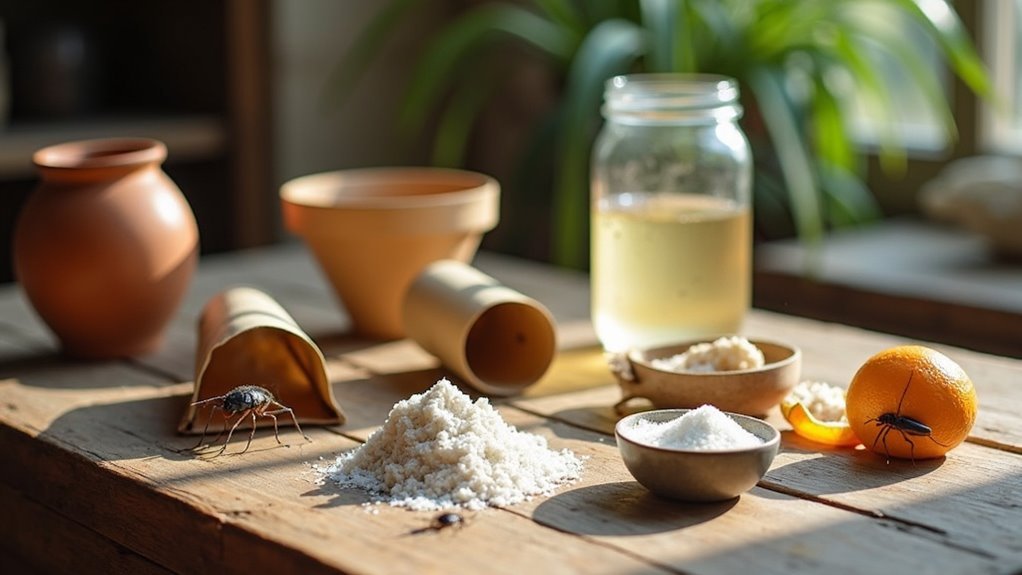You can eliminate roaches naturally using diatomaceous earth powder that dehydrates their exoskeletons, essential oil sprays with rosemary that disrupt their nervous systems, and catnip or bay leaf deterrent stations. Create effective bait traps by mixing borax with sugar or baking soda with onions, craft sticky jar traps using petroleum jelly, and sprinkle coffee grounds as repellent zones. These seven non-toxic methods protect your family while targeting roaches where they hide most.
Diatomaceous Earth Powder Traps

When you’re dealing with a roach infestation, diatomaceous earth offers a natural and effective solution that won’t endanger your family or pets. This non-toxic powder, made from fossilized diatoms, destroys roaches’ exoskeletons and dehydrates them upon contact.
You’ll want to sprinkle DE lightly in areas where you’ve spotted roaches frequently. The insects carry the powder back to their nests, reducing the overall population effectively.
Before applying diatomaceous earth, clean and seal all food sources to prevent contamination and guarantee roaches encounter the powder. This natural pest control method requires regular reapplication since moisture and disturbances reduce its effectiveness.
DE’s safety profile makes it ideal for households with children and animals, providing reliable roach control without toxic chemicals.
Essential Oil Spray Barriers
You can create powerful spray barriers using essential oils that’ll kill roaches on contact while keeping your home smelling fresh.
Rosemary oil stands out as the most effective option, achieving up to 100% mortality rates at concentrations between 2.5% and 30%.
If you’re concerned about pet safety, rosemary oil is your best choice since it’s safer for dogs and cats compared to eucalyptus or lavender oils.
Rosemary Oil Effectiveness
Although many essential oils claim pest control benefits, rosemary oil stands out with its impressive 100% mortality rate against roaches when used at concentrations between 2.5% and 30%.
This natural pesticide contains 1,8-cineole, an active compound that disrupts roaches’ nervous system upon exposure, causing death.
You’ll find rosemary oil safer for households with pets compared to eucalyptus or lavender oils, which can pose animal health risks.
Creating an effective repellent spray is simple—mix rosemary oil with water and apply it in common roach areas like kitchens and bathrooms.
Regular application provides dual benefits for pest control: eliminating roaches while leaving your home with a pleasant, fresh scent that enhances your living environment.
Pet-Safe Oil Options
Pet-safe essential oils sprays provide effective roach control without compromising your furry friends’ wellbeing.
You can create powerful natural repellent solutions using specific essential oils that won’t harm your pets while maintaining impressive effectiveness against roaches.
Here are proven pet-safe options for your roach control arsenal:
- Rosemary oil – Mix 2.5% concentration with water for safe, effective application
- Lavender oil – Gentle on pets while deterring roaches with its strong scent
- Eucalyptus oil – Creates barriers roaches won’t cross when properly diluted
- Catnip sachets – Contains nepetalactone that naturally repels roaches without spraying
- Bay leaves – Place whole leaves in cabinets and pantries for ongoing protection
Remember to reapply these natural repellent treatments regularly to maintain their deterrent properties and monitor effectiveness.
Catnip and Bay Leaf Deterrent Stations

You can create effective deterrent stations using catnip and bay leaves, which contain natural compounds that repel roaches through their strong aromas.
Strategic placement in kitchens, pantries, and under sinks maximizes their effectiveness by targeting high-traffic roach areas.
These natural repellents require regular replacement every few weeks to maintain their potency and guarantee long-term pest control success.
Natural Repellent Properties
When you’re looking for a gentler approach to roach control, catnip and bay leaves offer powerful natural repellent properties that don’t rely on harsh chemicals.
These botanical deterrent options create an effective roach-free environment while keeping your family and pets safe.
The non-toxic compounds in these plants work through distinct mechanisms:
- Catnip releases nepetalactone, which naturally repels roaches and prevents their return
- Bay leaves emit strong aromas that roaches find overwhelming and unpleasant
- Both plants provide long-lasting protection when strategically placed throughout your home
- You can safely use them in kitchens, pantries, and areas where children play
- Regular replacement maintains consistent deterrent effectiveness without chemical exposure
These natural alternatives prove that effective pest control doesn’t require compromising your family’s health or safety.
Strategic Placement Locations
To maximize your natural repellent system’s effectiveness, focus on positioning catnip and bay leaf stations in high-traffic roach hotspots where they’ll create the strongest barrier against infestations.
Strategic placement involves targeting areas where roaches commonly hide and travel. Place catnip sachels behind appliances, under sinks, and near water sources where moisture attracts pests. Bay leaves work best in pantries and cabinets, masking food odors that draw roaches.
| Location | Recommended Natural Deterrent |
|---|---|
| Kitchen appliances | Catnip sachets |
| Under sinks | Catnip sachets |
| Pantry shelves | Bay leaves |
| Cabinet corners | Bay leaves |
These non-toxic methods require regular monitoring and replacement to maintain potency. Check your deterrent stations weekly, replacing materials as their scenting properties diminish for continued roach prevention.
Long-Term Effectiveness
Since catnip and bay leaf stations require minimal maintenance while delivering consistent results, they’re ideal for homeowners seeking sustainable pest control solutions.
These natural deterrents maintain their effectiveness for weeks when properly refreshed, creating lasting barriers against roach infestations.
Your eco-friendly stations work continuously by releasing compounds that roaches find repulsive.
To maximize long-term success:
- Replace catnip sachets every 3-4 weeks to maintain nepetalactone potency
- Refresh bay leaves monthly or when their scent diminishes noticeably
- Monitor high-traffic roach areas and adjust placement as needed
- Combine both deterrents for enhanced protection throughout your home
- Document placement locations to guarantee consistent coverage over time
This non-toxic approach provides ongoing pest control without exposing your family or pets to harmful chemicals, making it a reliable long-term solution.
Borax and Sugar Bait Mixture

Although commercial roach baits can be expensive and contain harsh chemicals, you can create an equally effective trap using just two common household ingredients.
Mix three parts borax with one part sugar to create a powerful DIY roach killer that’s more non-toxic than traditional pesticides. The sugar attracts cockroaches while borax disrupts their digestive systems, making this homemade solution as effective as any sticky trap or commercial boric acid product.
Place this cockroach killer mixture in small containers or jar lids under sinks, behind appliances, and inside cabinets where roaches frequent.
You’ll see noticeable population reduction within one to two weeks. Keep the roach bait away from children and pets, as borax can be harmful in larger quantities.
DIY Sticky Jar Traps
While borax baits work by poisoning roaches, sticky jar traps capture them alive using simple materials you already have at home.
These DIY sticky roach traps offer a non-toxic approach that’s perfect for households with children and pets.
You’ll create an effective trap using petroleum jelly and sweet bait to attract roaches.
Here’s how to make your trap:
- Apply thick petroleum jelly around the jar’s rim to prevent escape
- Fill the bottom with sugar water or beer to attract roaches
- Place traps under sinks and behind appliances where roaches frequent
- Check traps regularly for captured insects
- Replace bait mixture as needed to maintain effectiveness
This safe alternative to chemical pest control captures roaches without using harmful substances, making it an excellent choice for eco-conscious homeowners seeking natural solutions.
Coffee Ground Repellent Zones
Beyond capturing roaches with traps, you can create protective barriers using coffee grounds to prevent infestations before they start. This natural pest control method works because roaches find coffee’s strong smell unappealing.
You’ll want to sprinkle used coffee grounds in areas where roaches commonly appear, like kitchens and near garbage cans.
The caffeine in coffee grounds acts as a toxin to insects, disrupting their nervous system when they contact it. This creates an effective repellent zone that keeps roaches away from treated areas.
Replace the grounds regularly to maintain their potency, as they lose effectiveness over time.
This eco-friendly approach offers a safe alternative for households with children and pets, eliminating the need for harmful chemicals while providing reliable roach deterrence.
Baking Soda and Onion Bait Traps
Since commercial roach traps can contain harmful chemicals, you’ll find that baking soda and onion bait traps offer a powerful yet safe alternative for eliminating these pests. This non-toxic method works because baking soda creates gas within roaches’ digestive systems that they can’t tolerate, ultimately killing them.
Creating these effective traps requires just a few simple steps:
- Mix equal parts baking soda and finely chopped onion
- Place mixture in shallow dishes
- Position traps where you’ve spotted roaches
- Replace bait every few days for maximum effectiveness
- Monitor areas for decreased roach activity
The onion’s strong scent acts as a natural attractant, luring roaches to consume the deadly baking soda mixture.
You’ll appreciate this method’s safety around children and pets while maintaining excellent pest control results.
Frequently Asked Questions
How to Get Rid of Roaches Without Toxic Chemicals?
You can eliminate roaches using sticky traps, borax-sugar bait, diatomaceous earth, essential oils like rosemary, or natural repellents such as catnip and bay leaves strategically placed around your home.
What Is the Best Homemade Roach Trap?
You’ll find the jar trap works best – coat a jar’s rim with petroleum jelly, add sugary bait inside, and place it near roach activity areas. They’ll climb in but can’t escape.
What Is the Best Non Toxic Roach Bait?
You’ll want to mix equal parts powdered sugar, yellow cornmeal, and borax for the most effective non-toxic roach bait. Place it under appliances and behind cabinets where roaches gather.
What Is the Best Homemade Roach Killer?
You’ll get excellent results mixing equal parts sugar and boric acid. The sugar attracts roaches while boric acid disrupts their digestive systems, creating an effective homemade killer that’s widely proven successful.
In Summary
You’ve got seven powerful, chemical-free options to tackle your roach problem naturally. Start with one or two methods that appeal to you, then expand your arsenal if needed. Remember, consistency’s key – maintain these traps and barriers regularly for best results. You’ll soon notice fewer roaches without exposing your family or pets to harsh toxins. Take action today and reclaim your home using nature’s own pest control solutions.





Leave a Reply